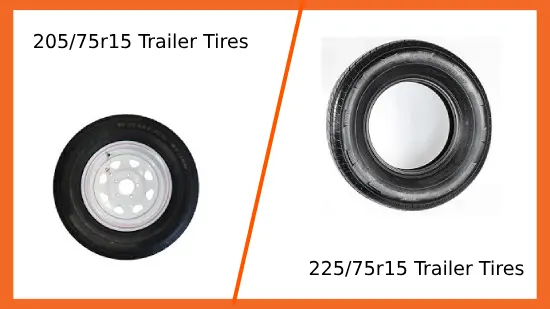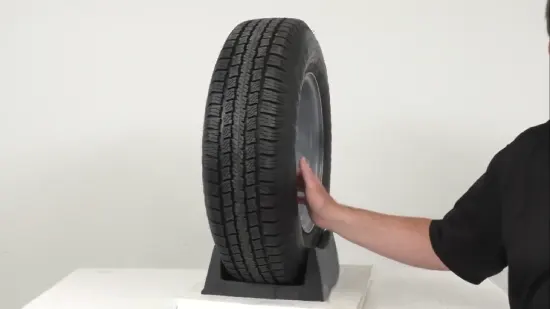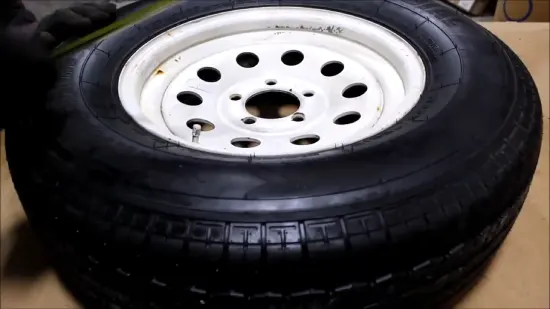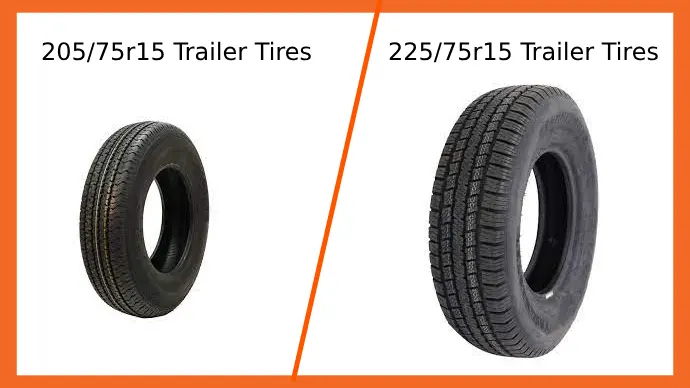Last Updated on July 24, 2023
Two common sizes for trailer tires are 205/75R15 and 225/75R15, and understanding the differences between them can help you make an informed decision. While both sizes are compatible with 15-inch wheels, there are some key differences to consider when choosing between them.
The 205/75R15 tire is narrower and ideal for 5 to 6 1/2 inch rims, whereas the 225/75R15 tire is wider and fits 6 to 7-inch wide rims. Also, the 205 tire stands at approximately 27.1 inches tall as opposed to the 225 tires has a taller height, measuring around 28.4 inches.
Today we’ll explore the disparities between two popular trailer tire sizes: 205/75R15 and 225/75R15. By examining factors such as width, fitment, height, load rating, speed rating, and more, we aim to provide you with a comprehensive overview to help you make an informed decision. Let’s discuss this.
205/75R15 vs 225/75R15 Trailer Tires: A Comprehensive Comparison

If you’re trying to decide between 75R15 and 225/75R15 trailer tires, there are a few key points to consider:
- Width and Fitment
- Tire Height
- Load Rating
- Speed Rating
- Mounting on Rims
- Winter Tire Differences
- Availability
#1 Width and Fitment
The width of a trailer tire greatly affects its stability and handling, and it’s important to note that the 225/75R15 tire, which can fit on a wider range of rims, is 20% wider than the 205/75R15 tire.
This means that the 225/75R15 tire will have a larger contact patch with the road, providing more stability and better handling when compared to the narrower 205/75R15 tire. However, it’s crucial to ensure that the tire fits properly on the rim, as using the wrong size can damage both the tire and the trailer.
Regarding fitment, the 205/75R15 tire is suitable for 5 to 6 1/2-inch rims, while the 225/75R15 tire fits 6 to 7-inch wide rims. Choosing the correct tire size for your trailer’s rim is important to ensure proper fitment and avoid any safety issues.
Using a tire that is too narrow or too wide for the rim can cause the tire to wear unevenly or even come off the rim while in use.
#2 Tire Height
You’ll want to pay attention to the height of your tire when choosing between the 205/75R15 and 225/75R15, as the difference could cause clearance issues.
The 205/75R15 tire stands at approximately 27.1 inches tall, while the 225/75R15 tire has a taller height, reaching around 28.4 inches. If you switch from 205s to 225s, you may need help with clearance, especially if your vehicle or trailer has limited space.
Load Rating
Considering the weight of your cargo, opting for the 225/75R15 tire with a higher load-carrying capacity could be the key to keeping your ride safe and secure, giving you peace of mind on the road.
While the 205/75R15 tire has a load rating of approximately 2100 pounds, the 225/75R15 tire offers a much higher load-carrying capacity, ranging between 2500 and 2800 pounds. This means that the 225/75R15 tire is better suited for heavier trailer loads, providing a higher level of safety and stability.
To better understand the importance of load rating, let’s take a look at the following table:
| Tire Size | Load Rating (lbs) | Maximum Pressure (psi) |
| 205/75R15 | 2100 | 50 |
| 225/75R15 | 2500-2800 | 50-65 |
Speed Rating
The 205/75R15 tire has a maximum speed rating of 75 mph, while the 225/75R15 tire can handle speeds between 75 and 87 mph. This means that if you plan on traveling at higher speeds, it’s recommended to choose the 225/75R15 tire for your trailer.
It’s also important to consider the intended use of your trailer and local speed limits when choosing a tire with the appropriate speed rating. If you frequently travel on highways with higher speed limits, the 225/75R15 tire may be a better choice to ensure safe and efficient travel.
Mounting on Rims
You can easily upgrade to a wider tire without changing your rims by mounting a 225/75R15 tire on 6 to 7-inch wide rims. These tires are designed to fit perfectly on these rims, just like a glove fits a hand. This feature offers flexibility in upgrading to a wider tire without changing the rims.
Here are three benefits of mounting a 225/75R15:
- Improved stability: The wider tire offers better stability and reduces the chances of the trailer swaying while towing.
- Increased load capacity: The 225/75R15 tire has a higher load capacity than the R15 tire, making it suitable for heavier loads.
- Better traction: The wider tire has a larger contact patch with the ground, resulting in better traction and improved braking performance.
Winter Tire Differences
When upgrading to winter tires note the differences between the 205/75R15 and 225/75R15 sizes. While both sizes have similar variations compared to their summer counterparts, there are slight differences in tread depth, load rating, weight, and specific winter performance characteristics.
The 225/75R15 size typically has a wider tread which can provide better traction in snowy and icy conditions. Additionally, the increased load rating of the 225/75R15 allows for heavier loads to be carried on the trailer.
However, the 205/75R15 size may be more suitable for smaller trailers due to its lighter weight and smaller size.
Availability
Both tire sizes, 205/75R15 and 225/75R15, are commonly found at various tire outlets such as Walmart, Les Schwab, Costco, and Big O Tires, among others. However, it’s always best to check with your local tire retailer for availability and specific brand options.
Some tire manufacturers may only offer one of the two sizes, while others may offer both. Note that availability may also differ depending on your location and the season. For instance, certain tire brands may be more readily available during the summer when there’s a higher demand for trailer tires.
What does the 205/75R15 mean on the tire?

Understanding the meaning behind the numbers on a tire, such as the 205/75R15, can provide valuable insight into the tire’s tread and construction.
The first numbers 205, refer to the width of the vehicle tire tread in mm. This measurement is taken from the widest point of the tire and is an important factor in determining the tire’s grip on the road.
The next number, 75, is the aspect ratio or profile of the tire. This is represented in the percentage of the tire width and indicates the height of the sidewall to the width of the tire. The higher the number, the taller the sidewall.
Finally, the ‘R’ stands for the construction method of the tire, indicating the tire is a radial tire while the final number, 15, is the diameter of the wheel in inches. Radial tires are constructed with layers of cords running radially, from bead to bead, making them more flexible and less prone to heat buildup.
The 205/75R15 tire size is commonly found on trailers and some smaller vehicles. This size is designed to provide a stable and comfortable ride while towing, and the construction of a radial tire offers a longer lifespan and improved performance.
Can I replace 205 tires with 225 trailers?
While replacing 205 tires with 225 trailer tires is possible, it’s important to consider the rim size. The 205 tire is designed to fit 5 to 6-1/2 inch wide rims, while the 225 is designed to fit 6 to 7 inch wide.
This means that if your rim is on the smaller end, the 225 tire may not fit appropriately and could cause issues with stability and handling.
It’s also important to note that the 225 tires will have a wider footprint than the 205 tire. This can be beneficial for towing heavier loads as it will distribute the weight across a larger surface area. Still, it can also impact gas mileage and put additional strain on the suspension.
How wide of a rim will a 225 tire fit?
A 225 tire can be fitted to a rim that is between 6 to 7 inches wide, which provides a wider footprint and distributes weight across a larger surface area. This is important because it helps to improve traction, stability, and handling.
When a tire is mounted on a rim that is too narrow, the sidewalls can bulge out and the tire can become stretched, which can cause it to wear out more quickly and even fail.
Conversely, if a tire is installed on a rim that is too wide, it can cause the tire to become pinched and result in premature wear or damage.
How many loads can 225 75R15 trailer tires hold?

With a maximum load rating of 2860 lbs, these DOT-approved 225 75R15 tires are a reliable choice for hauling heavy loads on US highways. Here’s what you need to know about their load capacity:
- Load rating is determined by the tire’s construction, size, and intended use. The load rating for a tire indicates the maximum amount of weight it can safely carry at a specific tire pressure.
- It’s important to properly inflate your tires to the recommended pressure to ensure you’re getting the full load capacity. Underinflated tires can reduce load capacity and lead to premature wear and tire failure.
- Overloading your trailer beyond the tire’s load capacity can be dangerous and increase the risk of tire blowouts, loss of control, and accidents.
- When choosing trailer tires, it’s important to consider the weight of your cargo, the trailer weight, and the weight distribution to ensure you’re selecting the right tire for your needs.
Choosing the Right Trailer Tires: Understanding Sizes and Compatibility
When choosing the right trailer tires, understanding the key differences between various sizes is crucial. Now you know that you can replace 205 tires with 225 trailer tires, but you need to ensure the rim width is compatible.
Regarding load capacity, 225/75R15 trailer tires can hold up to 2,540 pounds, making them a great choice for heavy-duty trailers. Whether you opt for the 205/75R15 or the 225/75R15, check the compatibility with your trailer’s rim width and the load capacity required for your specific needs.
Remember, just like a car’s tires, trailer tires are the foundation of your vehicle and can make all the difference in your journey.


